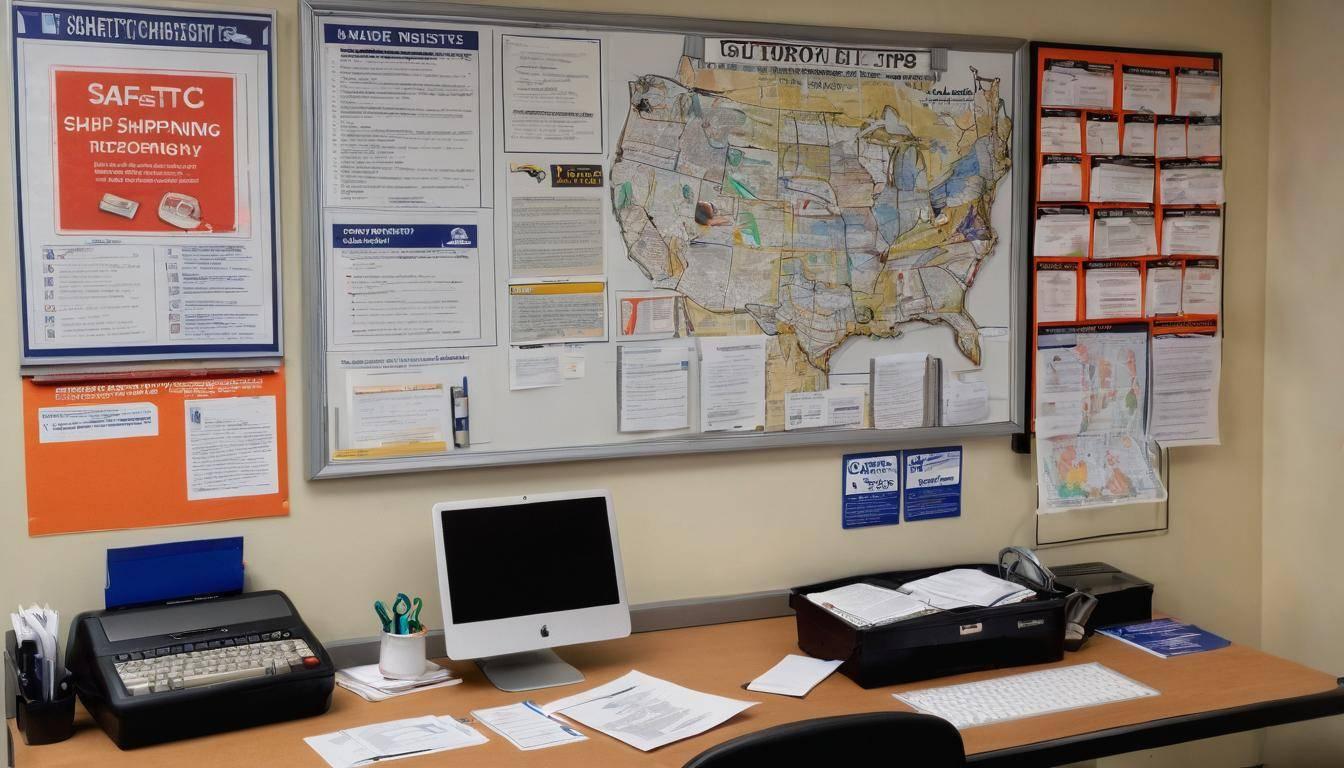Shipping your car across states can be nerve-wracking, especially with the fear of falling prey to scams. Many car owners have faced substantial financial loss because they didn’t know what warning signs to look for. This is particularly troubling when you consider your passion for cars and the value you place on your vehicle.
By thoroughly investigating this subject, gathering insights from experts, and exploring real-life experiences including our own, we’ve created this comprehensive guide to help you navigate car shipping safely. An imperative first step in protecting yourself is identifying reputable companies through diligent research and reliable metrics; this forms the cornerstone of a scam-free experience.
To avoid common scams when shipping your car, Buy Moving Leads advises to always ensure that the transport company is licensed and registered with the Federal Motor Carrier Safety Administration (FMCSA) and validate their Motor Carrier (MC) and DOT numbers. Additionally, read customer reviews on independent platforms, request clear documentation before committing, and never pay the full amount upfront to help safeguard against potential fraud.
Research and Choose a Reputable Company
When it comes to car shipping, you want to be sure you’re entrusting your vehicle to a dependable service. Start by ensuring that potential companies are registered with the Federal Motor Carrier Safety Administration (FMCSA). Their registration should include a valid Motor Carrier (MC) number and a USDOT number. These numbers indicate that the company meets federal safety regulations, which is crucial when it comes to protecting your vehicle during transport. To verify these numbers, simply head over to the FMCSA’s website.
Once you’re satisfied with their registration credentials, you can dive into customer feedback to get a clearer picture of their service reliability.
Check Customer Reviews
The importance of customer reviews cannot be overstated. According to a study by BrightLocal, an astounding 87% of consumers seek out online reviews before making a purchasing decision. This shows just how vital it is to take customer experiences seriously as they offer real-world insights into service quality. Websites like Trustpilot, the Better Business Bureau, and Google Reviews are good places to start your research. Curious about why certain companies shine while others fall short? High ratings coupled with positive comments often signal trustworthy operations.
Avoid getting too caught up in those glowing reviews alone; look for consistency in feedback and common themes among past customers. If multiple reviews mention issues like hidden fees or poor communication, it might be wise to steer clear.
Visit Physical Locations If Possible
If there’s any doubt still lingering in your mind, consider visiting the company’s physical location if it’s accessible. It may seem old-fashioned, but seeing the operations firsthand can provide peace of mind when making such an important choice. For instance, one satisfied customer shared her experience: “I chose a company with a local office I could visit. Seeing their operations firsthand gave me confidence in their service.” Standing in their office gives you more than just visibility; it affords you an opportunity to engage directly with staff and ask questions face-to-face.
Being proactive in choosing your car shipping company not only helps you avoid scams but also ensures that your vehicle is treated with care throughout its journey.
As you gain insights into choosing reliable services, it’s equally important to identify specific warning signs that indicate potentially fraudulent practices.
Warning Signs of Fraudulent Practices
Being aware of common warning signs can help you spot fraudulent car shipping companies. One glaring red flag is if a company demands full payment upfront before providing any service, which often indicates they might not have any intention of following through. Legitimate businesses typically allow for partial payments upon pickup or delivery, ensuring a more balanced exchange.
No Online Presence or Reviews
A strong online presence is essential for any reputable business today. Legitimate companies will usually have reviews available on platforms like Google, Yelp, or the Better Business Bureau. If you notice a company lacks online reviews or has a poorly designed website, this can be quite telling. Such absences often speak volumes about their legitimacy. The Better Business Bureau reports that over 80% of scam companies fail to maintain a proper online presence. This statistic highlights just how important it is to do your homework and search for reliable feedback from others who have used the service.
Unrealistic Pricing
Another major warning sign is unrealistic pricing. This may manifest as bait-and-switch pricing, where you receive an enticingly low quote only to find that the price skyrockets later due to hidden fees or changes in terms. While it may be tempting to go with a significantly lower bid, it’s vital to question why it’s below the industry standard, as this can often be an indicator of poor service or outright scams. Understanding the typical pricing landscape will equip you against these deceptive tactics.
Awareness and caution are your best tools in navigating the car shipping process. Keeping an eye out for these red flags goes a long way in safeguarding your interests and ensuring a smoother experience.
As you explore further into choosing a trustworthy provider, it’s essential to grasp the nuances involved in costs and methods of payment that can affect your overall transaction.
Understanding Fees and Payment Methods
Fee structures can make a world of difference when it comes to car shipping. A transparent fee structure isn’t merely a luxury; it’s a necessity for anyone looking to avoid getting scammed.
When dealing with car shipping companies, legitimate providers will offer you detailed quotes that outline every possible charge. This includes basic fees for delivery, additional charges for insurance, and any potential costs like fuel surcharges or extra fees for handling larger vehicles. By presenting everything up front, you know exactly what you’re paying for, which helps eliminate any chance of facing unexpected costs.
As crucial as understanding fees is knowing how to handle your payment safely.
Secure Payment Methods
When it comes to paying for your vehicle’s shipping, you need to prioritize security. It’s essential to avoid payment methods that lack traceability, such as MoneyGram or Western Union. These untraceable routes are often red flags, indicating that a company may not be operating legitimately. According to data from the FBI’s Internet Crime Complaint Center, many scams utilize these forms of payment precisely because they’re difficult to trace and recover. Imagine sending your hard-earned money only to discover later that the service has vanished without delivering the car – disheartening and frustrating.
Instead, always opt for credit card payments or bank transfers. Credit cards typically offer robust fraud protection; if anything goes wrong, you have recourse through your credit card company that can assist in disputing unauthorized charges.
Additionally, look for companies that accept escrow services for large transactions. This adds an extra layer of security where funds are only released once both parties agree that all terms have been fulfilled.
Maintaining diligence regarding transparent fee structures and secure payment methods is non-negotiable in your quest to avoid common scams in car shipping. Knowing what you’re paying for and protecting your payment method can help you navigate the potentially treacherous waters of vehicle transportation without falling victim to fraud.
With these precautions in mind, turning our attention to how you can best safeguard your vehicle during the shipping process will significantly enhance its journey.
Protecting Your Vehicle During Shipping
Protecting your vehicle goes beyond just choosing between open and enclosed transport options; it’s about being proactive in safeguarding it throughout the entire transportation process.
First and foremost, as indicated, selecting the right method is paramount. Open transport might save you a few bucks, but it leaves your car vulnerable to environmental hazards—think rain, snow, or flying debris from the road that could scratch or dent its pristine exterior.
On the other hand, enclosed transport may come at a premium, yet it’s well worth it for high-value vehicles like classics or luxury cars that need to be shielded from these elements.
When making this decision, consider not just the worth of your vehicle but also how often it travels. If it’s a beloved classic that sees limited mileage, investing in enclosed transport should be a no-brainer.
Once you’ve decided on the shipping method, the next critical element is ensuring adequate insurance coverage for any potential mishaps.
Ensure Proper Insurance Coverage
Before handing over your keys to a transport company, don’t hesitate to verify their insurance policy thoroughly. This step is essential; you wouldn’t skimp on insurance for your home or personal health, so why would you do so for your vehicle?
Scrutinize important details, such as coverage limits to understand how much damage is covered in case of an accident. Ask direct questions about the types of damages covered—whether it includes collisions while en route or only damage incurred during loading and unloading.
Here are some key points to check with significant clarity:
- Coverage Limits: Ensure they’re sufficient for the value of your vehicle.
- Types of Damage Covered: Confirm if it encompasses both minor scratches and major accidents.
- Proof of Insurance Certificate: Always request this document before finalizing any agreements.
Additionally, depending on the company’s coverage and limitations, it might be wise to consider purchasing supplementary insurance for added security. This can provide peace of mind when entrusting your vehicle to another party. Just imagine driving a rare vintage model across state lines; wouldn’t you want every possible safeguard in place?
By carefully selecting the transport method and conducting thorough checks on insurance coverage, you create layers of protection that significantly reduce risks associated with car shipping. With these measures in place, you can confidently focus on understanding your entitlements and the necessary paperwork surrounding your shipment.
Legal Rights and Documentation
Knowing your legal rights and ensuring that you have the appropriate documentation is essential in safeguarding yourself from potential scams in car shipping. This gives you peace of mind and provides a solid ground to stand on should disputes arise. One of the most vital documents you will encounter during the shipping process is the Bill of Lading.
Bill of Lading
The Bill of Lading is more than just a piece of paper; it is a vital legal document that establishes the agreement between you, the shipper, and the carrier. It outlines the type, quantity, and destination of the vehicle being transported. This document serves dual purposes: it acts as both a receipt for the goods being shipped and a binding contract that ensures the carrier has specific responsibilities while your vehicle is in transit.
It’s important to review this document carefully before signing it. Ensure that all details are accurate, including your contact information, vehicle description, and agreed-upon delivery dates. Any discrepancies might lead to complications later on. Furthermore, keep a copy for your records as it will be invaluable if any issues come up.
Another critical document that plays an essential role during shipment is the Vehicle Condition Report.
Vehicle Condition Report
The Vehicle Condition Report is crucial because it records your car’s condition prior to shipping. Having this report ensures there is no ambiguity regarding any existing damages or imperfections on your vehicle when it leaves your possession. It’s advisable to take detailed photos of your vehicle from multiple angles—these will serve as valuable evidence in case damage occurs during transport.
When documenting your vehicle’s condition, include images of any significant scratches or dents, along with interior photos showing the state of the upholstery. Ensure these records are timestamped so their authenticity can withstand scrutiny. These proactive steps can help mitigate disputes over responsibility for damages if they arise upon delivery.
In addition to these key documents, understanding other paperwork involved in car shipping contributes to a transparent and secure transaction. With this knowledge in hand, you can better navigate the potential pitfalls often encountered during vehicle transport.
Expert Tips for Reliable Car Shipping
One of the first and most crucial steps in ensuring a seamless car shipping experience is to get multiple quotes. Obtaining estimates from at least three different auto transport companies allows you to not only compare prices but also assess the range of services offered. This process gives you a clearer understanding of the market and can help you identify any unusually low or high pricing, potentially flagging companies that could be operating with unscrupulous practices. John Smith, an auto transport advisor, notes that this strategy was instrumental in his experience: “Getting multiple quotes gave me a better understanding of what to expect and helped me avoid overpriced or suspiciously cheap offers.”
Once you’ve gathered your quotes, the next logical step is to verify licensing.
Always check that the transport company is properly licensed with the Federal Motor Carrier Safety Administration (FMCSA). This verification isn’t just about crossing off another item on your checklist; it serves as your peace of mind. Using tools like the FMCSA’s Licensing and Insurance system will confirm that your chosen company has met regulatory standards, thereby assuring you of their legitimacy. Engaging with an adequately licensed transporter can save you from future headaches related to claims or liability issues.
While researching online is essential, don’t underestimate the power of personal referrals.
Personal recommendations can lead you to some hidden gems in the car shipping business. Friends, family, or even coworkers who have successfully shipped vehicles can provide invaluable insights and experiences. Emily White shares her own story: “I chose my transporter based on a friend’s recommendation, which really helped alleviate any uncertainty I had.” Such firsthand accounts can steer you away from brokers or companies that might not meet your expectations.
While personal connections add trust, it’s pertinent to consider whether to avoid brokers altogether.
Dealing directly with carriers can often mitigate the middleman fees and potential miscommunications associated with brokers. While brokers can sometimes save time by managing logistics for you, it’s important to note that they may charge additional fees for their services. By cutting out the middleman, you’ll likely reduce costs and improve communication since you’ll be dealing directly with the people handling your vehicle transportation.
Here’s a summary of these expert tips for reliable car shipping:
| Tip | Details |
| Get Multiple Quotes | Compare at least three companies for better pricing. |
| Verify Licensing | Use FMCSA’s system to check company licenses and insurance. |
| Personal Referrals | Ask friends or family for recommendations. |
| Avoid Brokers | Deal directly with carriers to save money and prevent issues. |
Armed with these expert tips, you can navigate car shipping decisions with greater assurance and security, setting yourself up for a positive experience every step of the way.
By taking these proactive steps, you’re well on your way to ensuring a reliable and hassle-free car shipping process. Your diligence will help protect both your investment and peace of mind throughout this journey.
Keep an eye for more news & updates on DiscoverTribune!




